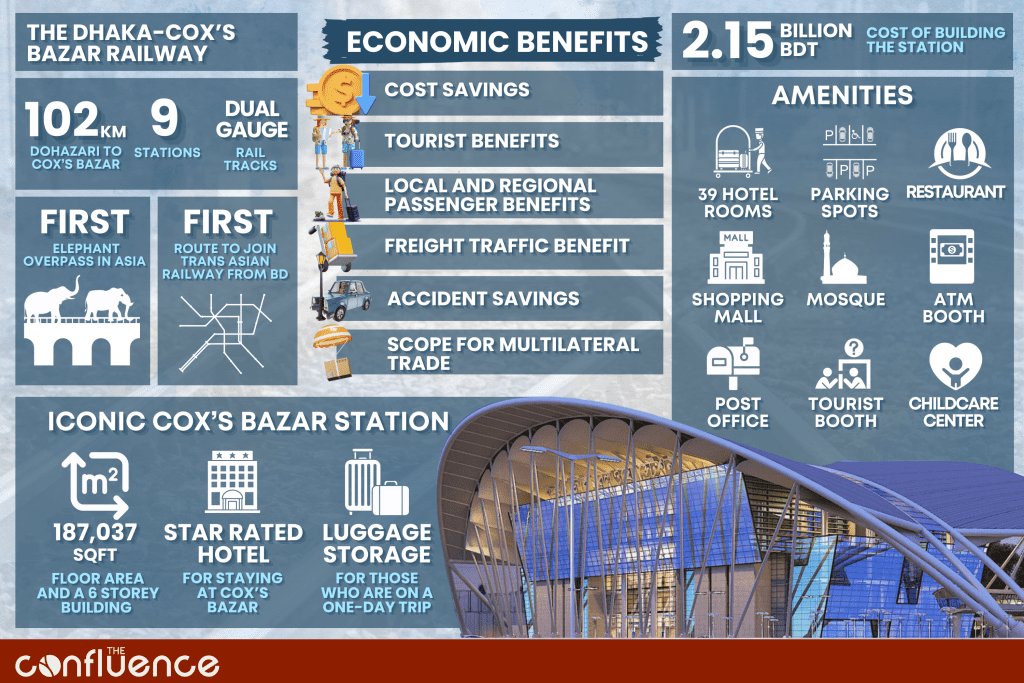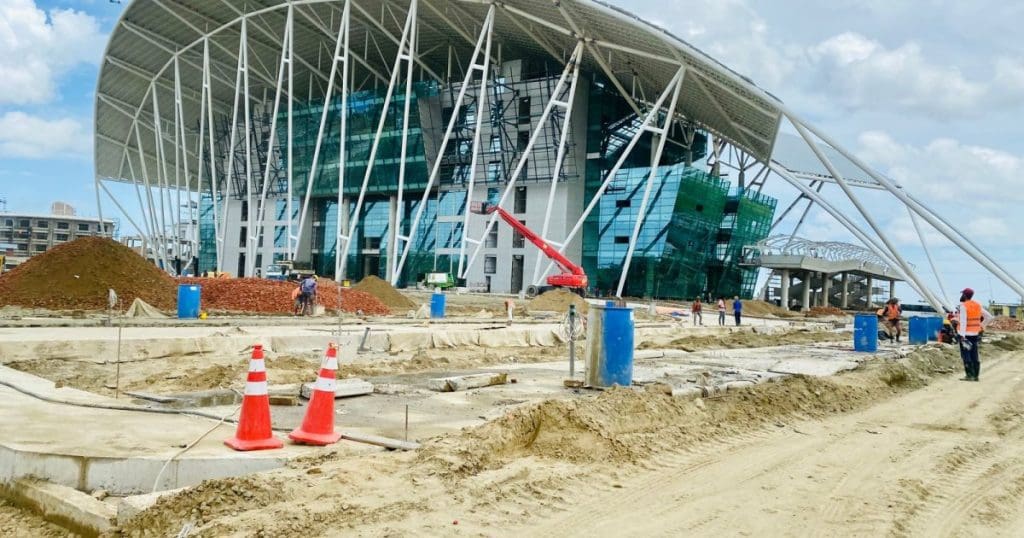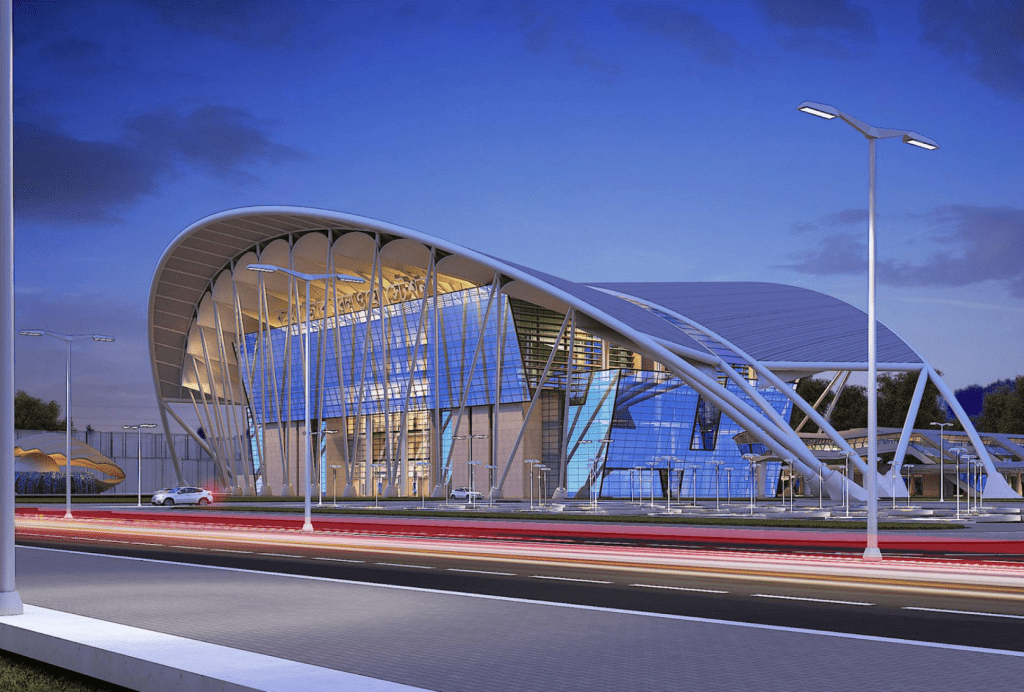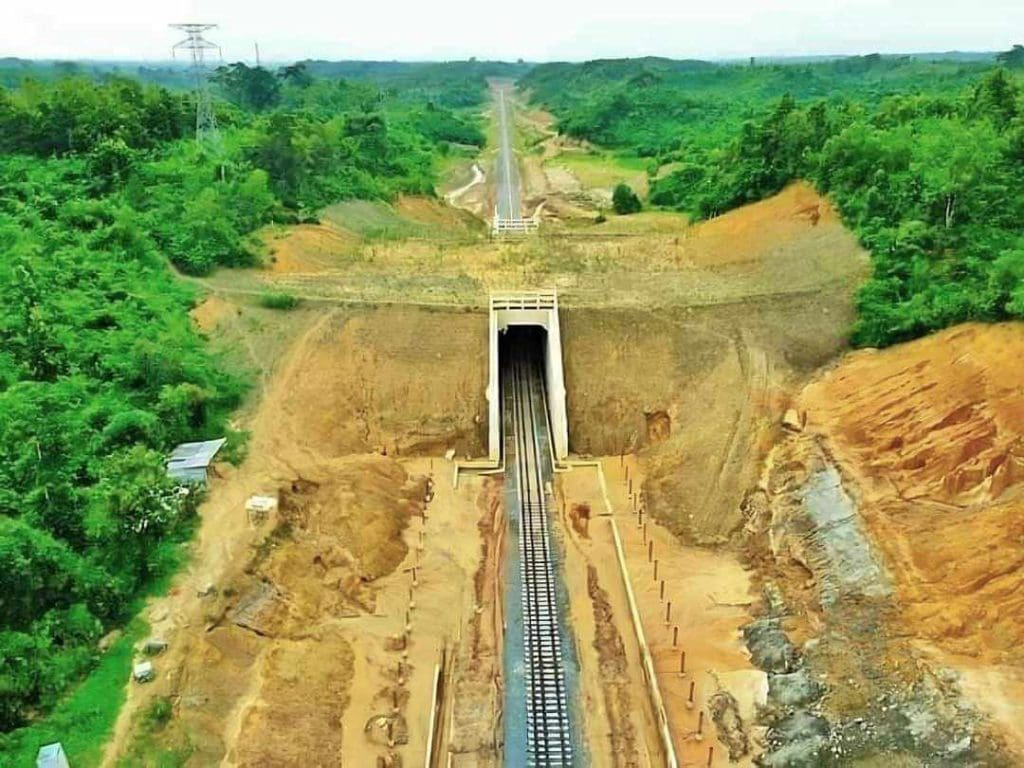The eagerly awaited Dhaka-Cox’s Bazar railway line, set to pass through Chattogram, is poised to open its doors to passengers in October 2023. The construction of broad-gauge lines in the east will not only make it easier for people all over the county to visit Cox’s Bazar but also further facilitate Bangladesh’s connection to China, Pakistan, India, and Myanmar via the Trans-Asian Railway link. Moreover, it will strengthen the government’s mega plan to establish Cox’s Bazar as an economic hub like Hong Kong.
Cox’s Bazar has always been the sweet spot for the tourism sector in Bangladesh. Not only in national revenue, Cox’s Bazar has an active role in employment creation for the country. In 2019, Cox’s Bazar contributed 4.4% of the GDP to the national economy. During peak seasons, Cox’s Bazar can record business as high as more than BDT 100 crore per day from tourism. The government’s initiative to transform Cox’s Bazar into an economic hub between South Asia and Southeast Asia includes at least 77 development projects, one of which is the Cox’s Bazar railway link.
Contribution of Cox’s Bazar to the GDP
Source: World Travel and Tourism Council Data (2019)
No Data Found
Current
Challenges
in Connectivity
Presently, the state of rail connectivity between Dhaka and Cox’s Bazar is less than ideal. Two major issues, namely the structural deterioration of the Kalurghat bridge and the unsatisfactory state of the Chattogram-Dohazari railway section, pose significant challenges to rail travelers. These hurdles, while potentially daunting, are not insurmountable. Moreover, the Kalurghat bridge, which was built as a rail bridge in 1931 and later converted into a rail/road bridge in 1962, is now unsafe and requires repairs to keep it usable. Heavy locomotives cannot use it, and the bridge stands with a speed limit of only 10 kmph, rendering it off-limits for robust locomotives and freight trains. Bangladesh Railway has undertaken a restoration project costing BDT 60 crore to facilitate a change in the bridge’s speed limit. Moreover, the poor condition of more than 50 kilometers of connecting road for the kalurghat bridge sets back the overall traffic scenario. It generally takes more than six hours to reach Cox’s Bazar from Chittagong.

An Abridgement of the Cox’s Bazar Railway
The Dhaka-Cox’s Bazar tourist railway project has excellent technological specifications and a variety of amenities designed to improve the travel experience for passengers and the efficiency of the transportation system. The rail route is dual-gauge and spans 102 kilometers, making it compatible with a variety of rail networks. Nine stations spaced out along its path house necessary amenities like relay batteries, generator rooms, sewage and waste management facilities, and environmentally friendly additions like solar panels to encourage long-term use and reduce environmental impact. In addition, the train is made to accommodate a wide range of passengers, with designated areas for women, children, the elderly, and people with impairments. Secure luggage storage is available at the stations, allowing up to five hundred visitors to the area to enjoy the sights without having to haul their possessions around. With such a thorough approach to infrastructure and passenger services, the Dhaka-Cox’s Bazar tourist railway is positioned as a cutting-edge and effective mode of transportation, ensuring that passengers have a pleasant and relaxing ride while also facilitating the transport of goods, adding to regional connectivity, and stimulating the tourism industry.
The Iconic Cox’s Bazar Railway Station
The Cox’s Bazar Railway station is the most recent railway station to join Bangladesh’s rail network. Being built in a modern era, the architecture of this station has embraced modernity and lucrativeness. The exterior of the station is constructed to look like an oyster representing the scenic attraction of Cox’s Bazar.

0
Sqft
Floor Area
The six-story station building has an area of 187,037 square feet, spanning 29 acres of land. It is expected to house star-rated hotels, shopping malls, and restaurants. More importantly, there will be luggage storage facilities for the tourists. This will allow the tourists to store their luggage and enjoy the beach before they leave for the next train. That means tourists can now board a train from Dhaka at night and reach Cox’s Bazar in the morning, enjoy the beach all day, and get a train back to Dhaka at night, keeping all their belongings at the station all day.

Keeping Wildlife in Mind
An important turning point for both railway safety and wildlife protection has been reached with the installation of the first elephant flyover across the Cox’s Bazar railway. This engineering marvel is set to be the first ever elephant overpass on rail track in Asia. Elephants may now cross railway tracks safely thanks to this creative project, which also lowers the chance of collisions and protects the area’s rare wildlife. These amazing animals will have a key passageway made possible by the flyover, which will reduce confrontations between humans and wildlife. It is an excellent illustration of how infrastructural development and environmental protection can coexist peacefully in the Cox’s Bazar region.

Economic Benefits and Feasibility
The existing railway bottlenecks have significant repercussions on rail operations. Heavy locomotives are unable to traverse the Kalurghat bridge safely, and the Chattogram-Dohazari section operates at a suboptimal speed limit of 48 kilometers per hour. These speed limitations and poor road conditions severely hamper the efficiency and effectiveness of commuting along this route. Thus, the cost of traveling goes up. Moreover, due to extended travel distance, annual operating costs for the vehicle increase as well.
The economic rate of return for this project is 14.8%, according to a feasibility study by the Asian Development Bank. The same study also illustrates the net benefit of BDT 10288 million in 2024 against the summed-up capital cost and operations cost of BDT 1582 million. This net benefit is expected to reach BDT 88,697 million per year by 2046.
0
Million USD /Year
Economic Benefit by 2046
Cost Savings
The absence of proper rail connectivity and the poor condition of roads have made tourists, regular commuters, and cargo transportation heavily dependent on motor vehicles. Commuters choose either luxury buses or their own medium of transportation; both incur high operating costs. The Dhaka-Cox’s Bazar railway will reduce these costs significantly. Upon starting, the cost savings from luxury bus and car operations (VOC) will be BDT 4472 million in 2024. This is expected to reach BDT 11866 million by 2046.
Tourist Benefits
Increased travel costs affect the overall tour experience. Besides that, an uncomfortable journey experience, which is hard to quantify, has an impact on the tourists as well. ADB projects that overall tourist benefits gained from the railway will be around BDT 4125 million in 2024, which is expected to reach BDT 15050 million by 2046. As the rail will speed up travel, leading to a remarkable saving in travel time, the net tourist benefits will include time savings as well.
Local and Regional Passengers Benefits
Local and regional passengers who often have to travel on this route will be able to use trains as their primary mode of transportation, as train trips are significantly cheaper. This will contribute to the revenue as well. The ADB study expects net benefits of local and regional passengers to be BDt 1905 million in 2024, rising up to BDT 6533 million in 2025
Freight Traffic Benefits
Along with local and regional passengers, freight transport also contributes a significant part of this territory’s revenue. With the inauguration of this railway, the net freight revenue is estimated to be BDT 974 million in 2024. Previously, due to the lack of rail connectivity, enterprises were heavily reliant on trucks and vans. This reliance is expected to be replaced by the rail collecting a net freight revenue of BDT 2263 million by 2046
Accident Savings
Relying on the road transportation system, where a tremendous amount of unfit vehicles travel through this route from Dhaka to Cox’s Bazar, has been contributing to the increased number of deaths and fatalities due to road accidents. Historically, the district of Cox’s Bazar, with its connecting routes, has been one of the most prominent entities when it comes to accident frequency. With cars, buses, and trucks being replaced with the rail connection, it is expected to reduce the frequency of accidents by a remarkable margin. The savings from accidents are expected to be BDT 393 million in 2024, which is expected to be BDT 934 million in 2046.
Scope for Multilateral Development
Apart from tourism, Cox’s Bazar’s economy relies on agriculture, salt, and dried fish. With this rail connectivity, transportation costs will reduce significantly. Farmers and producers are expected to get a better price due to the ease of transporting in and out of Cox’s Bazar.
Topping up the Trans Asian Railway
With the completion of Dhaka-Cox’s Bazar Railway, the Bangladesh part of Trans Asian Railway route-1 is set to wrap up. TAR, or the Trans Asian Railway, is a regional transport cooperation that will reinforce the railway structure. Route 1 of the TAR will connect West Bengal, Bangladesh, and Myanmar.
Gede (West Bengal)- Darshana (Chuadanga)- Ishwardy- Jamtoli- Jamuna Bridge- Joydevpur- Tongi- Akhaura- Chattogram- Dohazari- Gundum- Myanmar
TAR will accommodate and contribute to the significantly increased international trade between Eurasian countries and reinforce the smoother transportation of goods between the countries.
Finance and Overruns
The Dhaka-Cox’s Bazar rail project, initially budgeted at Tk 1,852.35 crore with a target completion date of June 2013, encountered significant changes and challenges over the years. Notably, the decision to include dual-gauge lines and provisions for double lines caused the project’s cost to skyrocket to Tk 18,034.47 crore. Additionally, the project underwent further revisions, including a shift in the endpoint from Ramu’s Gundum to another location near the Myanmar border. The Dohazari-Ramu section, measuring 100 kilometers, commenced physical construction in March 2018, with a current deadline set for completion in June 2024.
The government has laid out two vital projects. The first project involves constructing a new bridge at Kalurghat, while the second aims to enhance the Chattogram-Dohazari section.
Expectations
Looking to the future, significant enhancements in rail operations are anticipated once the new Kalurghat bridge is constructed and the Chattogram-Dohazari section receives substantial upgrades. These improvements promise to offer passengers a smoother and more efficient travel experience. Moreover, the positive economic and tourism-related impacts of enhanced rail connectivity are expected to be substantial, further solidifying the importance of these projects.
The structural condition of the Kalurghat bridge and the operational limitations of the Chattogram-Dohazari section are formidable challenges that require careful planning and execution. The initiative to resolve these issues, coupled with lessons learned from past experiences, offers hope that this significant rail project will eventually reach its full potential, providing travelers with a smoother and more efficient rail connection between Dhaka and Cox’s Bazar.
About the Author

Hamim Mubtasim is the Brand Manager at The Confluence. He is currently pursuing his undergraduate studies at the Institute of Business Administration, University of Dhaka. A business student by choice and marketing geek by passion, he aspires to manage big brands someday.
1 comment
[…] Management: Destigmatization for Development Why Bangladesh’s Delta Plan 2100 Matters Exploring The Dhaka-Cox’s Bazar Railway The Digital Security Act: Reform or Abolish? Grappling with Global […]